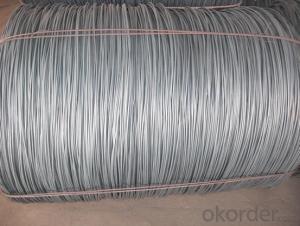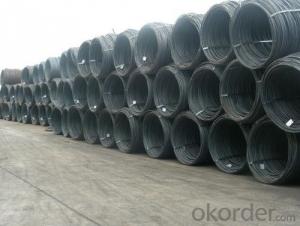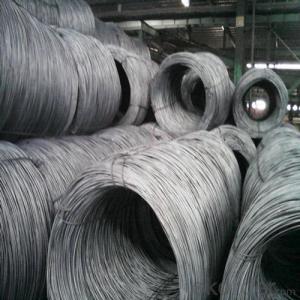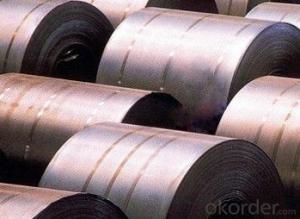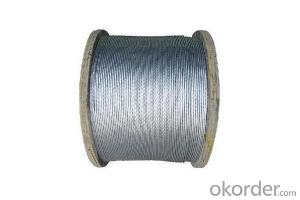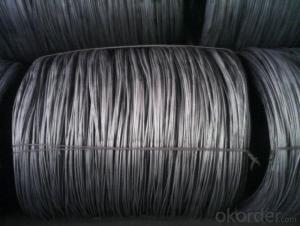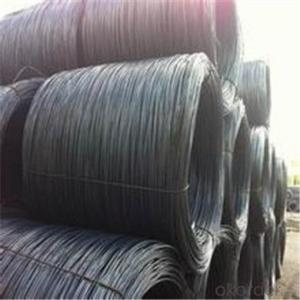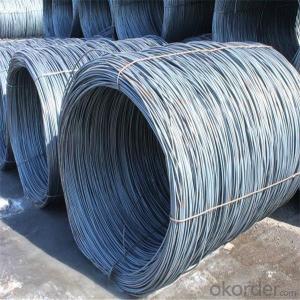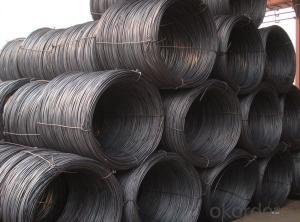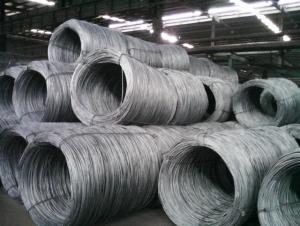Wire Rod Hot Rolled High Quality 5.5MM-14MM
- Loading Port:
- Tianjin
- Payment Terms:
- TT OR LC
- Min Order Qty:
- 25 m.t.
- Supply Capability:
- 2000000 m.t./month
OKorder Service Pledge
OKorder Financial Service
You Might Also Like
Specification
Product Description:
OKorder is offering high quality Hot Rolled Steel I-Beams at great prices with worldwide shipping. Our supplier is a world-class manufacturer of steel, with our products utilized the world over. OKorder annually supplies products to European, North American and Asian markets. We provide quotations within 24 hours of receiving an inquiry and guarantee competitive prices.
Product Applications:
After hot-rolled the products shaped into coil and delivery as finished product, including round, square, rectangular, hexagonal and so on. Since most of the products are round, it is generally called wire rod. Carbon steel wire rod is widely used in construction and manufacturing. Carbon steel wire rod is mainly used for reinforcement of reinforced concrete and welded structure or reprocessed (roberts , nail, etc.) materials, especially used to produce wire drawing, welding electrode, nails, spring, electronic, precise machinery parts and so on.
Product Advantages:
OKorder's Steel I-Beams are durable, strong, and resist corrosion.
Main Product Features:
· Premium quality
· Prompt delivery & seaworthy packing (30 days after receiving deposit)
· Corrosion resistance
· Can be recycled and reused
· Mill test certification
· Professional Service
· Competitive pricing
Product Specifications:
Manufacture: Hot rolled
Grade: SAE1008 SAE 1006
Certificates: ISO, SGS, BV, CIQ
Diameter: 5.5mm, 6.5mm, 7mm,8mm,9mm,10mm,12mm,14mm, as per customer request
Packaging: Export packing, nude packing, bundled
Grade | Chemical Composition (%) | |||||
C | Mn | S | P | Si | B | |
SAE1008B | 0.10max | 0.32max | 0.045max | 0.040max | 0.30max | 0.0008min |
Mechanical properties | ||||||
Yield strength(N/mm2) | Tensile strength(N/mm2) | Elongation (%) | ||||
≥195 | 350-380 | ≥32 | ||||
FAQ:
Q1: How soon can we receive the product after purchase?
A1: Within three days of placing an order, we will begin production. The specific shipping date is dependent upon international and government factors, but is typically 7 to 10 workdays.
Q2: What makes stainless steel stainless?
A2: Stainless steel must contain at least 10.5 % chromium. It is this element that reacts with the oxygen in the air to form a complex chrome-oxide surface layer that is invisible but strong enough to prevent further oxygen from "staining" (rusting) the surface. Higher levels of chromium and the addition of other alloying elements such as nickel and molybdenum enhance this surface layer and improve the corrosion resistance of the stainless material.
Q3: Can stainless steel rust?
A3: Stainless does not "rust" as you think of regular steel rusting with a red oxide on the surface that flakes off. If you see red rust it is probably due to some iron particles that have contaminated the surface of the stainless steel and it is these iron particles that are rusting. Look at the source of the rusting and see if you can remove it from the surface.
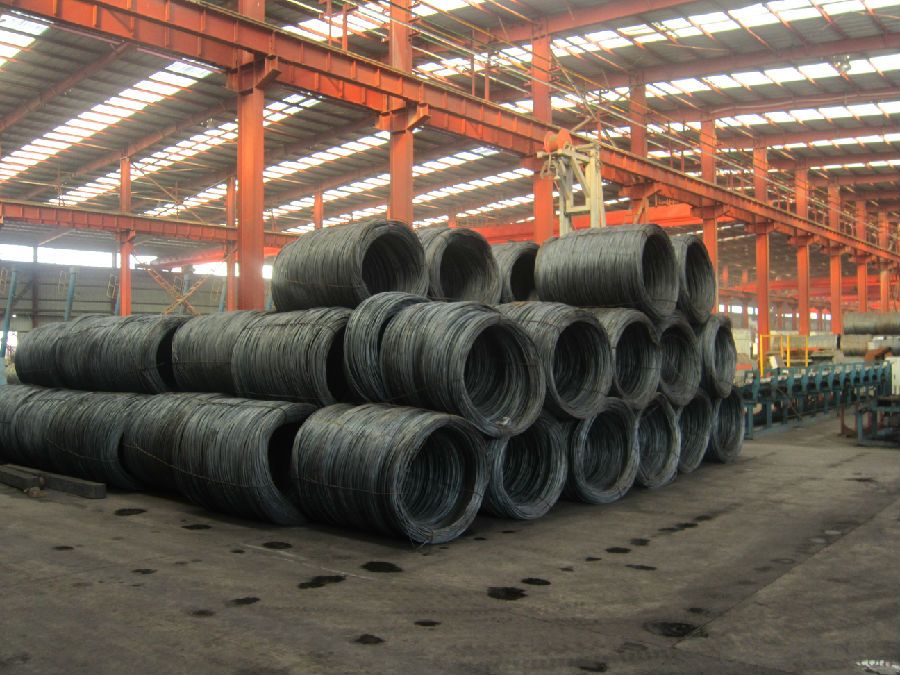
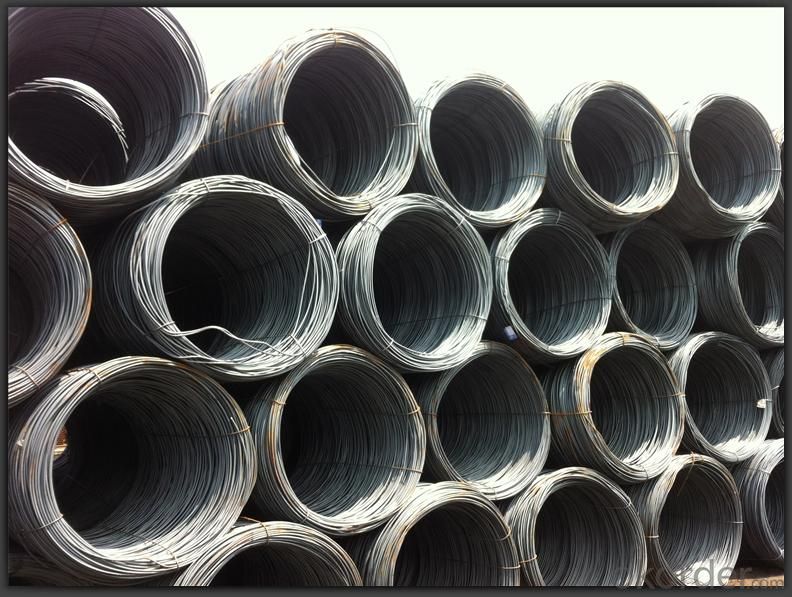
- Q: How is steel wire rod used in the production of nails and screws?
- Nails and screws heavily rely on steel wire rod as a vital raw material. This exceptionally strong and durable material serves as the base for manufacturing these fasteners. To enhance its properties, the steel wire rod undergoes a series of mechanical and heat treatments. In the nail production process, the steel wire rod goes through a wire drawing machine to reduce its diameter and increase its length. This step not only improves the wire's tensile strength and smoothness but also elongates it. After being drawn, the wire is cut into specific lengths and sharpened at the ends to form nail points. Once the nails take shape, they undergo a heat treatment process called tempering. This involves subjecting them to high temperatures and then rapidly cooling them. The purpose of tempering is to increase the nails' hardness and resistance to bending or breaking, ensuring they can withstand the stress and pressure they'll encounter during use. Similarly, in screw production, the steel wire rod is drawn and cut into specific lengths. These lengths are then threaded by rolling or cutting grooves along the wire's surface, giving the screw its spiraled shape. The threading process adds strength, enabling the screw to securely fasten materials together. The steel wire rod used for nails and screws is usually made from low-carbon, high-carbon, or alloy steel. Each type of steel offers specific properties, such as corrosion resistance or increased strength, depending on the intended application of the fasteners. All in all, steel wire rod plays a vital role in the production of nails and screws. Its strength, durability, and versatility make it an ideal material for these fasteners, ensuring they can effectively hold materials together in various construction, manufacturing, and household applications.
- Q: How is steel wire rod straightened and cut to length?
- The process of straightening and cutting steel wire rod, known as straightening and cutting, involves the use of a machine. This machine, referred to as a straightening machine, aids in the elimination of any bends or twists in the wire rod by feeding it through a series of rollers that exert pressure and gradually straighten it. Once the wire rod is straightened, it is then passed through a cutting machine that is specifically designed to cut through steel wire rods. This cutting machine is equipped with a blade or cutting tool and allows for the rod to be cut into the desired lengths. The length is determined by setting the desired length on the machine. The straightening and cutting process can be carried out either automatically or manually, depending on the scale of production. In automated systems, the wire rod is fed into the straightening and cutting machines through mechanisms such as conveyor belts. The desired length is set on a control panel, and the machines automatically straighten and cut the rod accordingly. For smaller scale operations, manual straightening and cutting are commonly employed. In this case, an operator manually feeds the wire rod into the straightening machine and then uses a cutting tool to manually cut it to the desired length. This process requires skill and precision to ensure accurate and precise straightening and cutting. Overall, the process of straightening and cutting steel wire rods is crucial in manufacturing precise lengths and straightness. It plays a vital role in industries such as construction, automotive, and manufacturing, where steel wire rods are utilized in various applications.
- Q: Can steel wire rod be used for reinforcement purposes?
- Yes, steel wire rod can be used for reinforcement purposes. Steel wire rod is often used to reinforce concrete structures such as buildings, bridges, and highways. This is because steel has high tensile strength and can withstand heavy loads and stresses. When embedded in concrete, the steel wire rod helps to increase the overall strength and durability of the structure. It also helps to prevent cracking and improve the structural integrity. Steel wire rod is commonly used in the construction industry for reinforcement purposes due to its excellent mechanical properties and ability to enhance the performance of concrete structures.
- Q: How is steel wire rod used in the manufacturing of wire forms for fishing nets?
- Steel wire rod is a crucial component in the manufacturing of wire forms for fishing nets. The wire rod serves as the raw material from which the wire forms are created. Firstly, the steel wire rod is processed through a series of steps to transform it into a usable wire form. This includes cleaning, annealing, and drawing the wire rod to achieve the desired diameter and tensile strength. These processes ensure that the wire is strong and flexible enough to withstand the tension and stress it will experience when used in fishing nets. Once the wire rod is transformed into wire, it is then used to create the various wire forms required for fishing nets. These wire forms include various components such as hoops, rings, loops, and connectors that are essential for constructing a functional fishing net. The wire forms are created using specialized machinery and techniques, including bending, cutting, and welding the wire according to the specific design requirements. These wire forms are then assembled together to form the net structure. The use of steel wire rod in the manufacturing of wire forms for fishing nets provides numerous advantages. Steel is known for its high strength and durability, making it ideal for withstanding the harsh conditions and constant tension that fishing nets are subjected to. Additionally, steel wire rod is resistant to corrosion, ensuring that the wire forms will have a long lifespan even when exposed to water and other environmental factors. In conclusion, steel wire rod is a vital component in the manufacturing of wire forms for fishing nets. It serves as the raw material from which the wire forms are created, providing the necessary strength, flexibility, and durability required for a functional fishing net.
- Q: What are the different shapes of steel wire rod available?
- There are various shapes of steel wire rods available, including round, square, rectangular, hexagonal, and octagonal.
- Q: What are the different factors that affect the mechanical properties of steel wire rod?
- There are several factors that can affect the mechanical properties of steel wire rod. These factors include the composition of the steel, the heat treatment process, the rolling process, and the presence of any impurities. The composition of the steel plays a significant role in determining its mechanical properties. Different elements, such as carbon, manganese, and silicon, are added to the steel in varying amounts to achieve specific properties. For example, a higher carbon content can increase the strength and hardness of the steel, while the addition of alloying elements like chromium or nickel can enhance its corrosion resistance. The heat treatment process also has a significant impact on the mechanical properties of steel wire rod. Heat treatment involves heating the steel to a specific temperature and then cooling it rapidly or slowly to alter its microstructure. This process can affect properties such as strength, hardness, and toughness. For instance, quenching and tempering can increase the hardness and strength of the steel, while annealing can improve its ductility. The rolling process, which involves reducing the size of the steel wire rod through mechanical deformation, also affects its mechanical properties. The amount of reduction, the number of passes, and the rolling temperature can all influence the final properties of the wire rod. Higher reductions and lower rolling temperatures generally result in finer grain structures and improved mechanical properties. Impurities present in the steel, such as sulfur, phosphorus, and non-metallic inclusions, can also impact its mechanical properties. These impurities can weaken the steel and reduce its ductility and toughness. Therefore, maintaining low levels of impurities through proper refining and alloying processes is essential to achieve desired mechanical properties. In conclusion, the mechanical properties of steel wire rod are influenced by a combination of factors including the composition of the steel, the heat treatment process, the rolling process, and the presence of any impurities. Understanding and controlling these factors is crucial in producing steel wire rods with desired properties for various applications.
- Q: What are the common sizes and dimensions of steel wire rod?
- The common sizes and dimensions of steel wire rods vary depending on the specific application and industry requirements. However, some commonly used sizes range from 5.5mm to 12mm in diameter, with lengths typically between 2,000mm and 3,000mm. These dimensions are commonly used in construction, manufacturing, and automotive industries, but it's important to note that there are various other sizes available to cater to specific needs.
- Q: What are the main trade associations and organizations in the steel wire rod industry?
- The steel wire rod industry is supported by several prominent trade associations and organizations. These include: 1. The American Wire Producers Association (AWPA), which represents wire producers, suppliers, and consumers in North America. Their goals involve advocating for wire product usage and advancing the industry through education, networking, and advocacy efforts. 2. The International Wire & Machinery Association (IWMA), a global association that brings together wire and cable manufacturers, suppliers, and machinery companies. They facilitate networking and knowledge sharing through events, conferences, and exhibitions. 3. The Wire Association International (WAI), a non-profit association committed to promoting the interests of the wire and cable industry worldwide. They provide technical resources, training programs, and industry updates to encourage collaboration and innovation within the steel wire rod sector. 4. The International Iron and Steel Institute (IISI), although not specific to the wire rod industry, represents the global steel industry, including producers, distributors, and other stakeholders. They serve as a platform for industry collaboration, policy advocacy, and the exchange of information. 5. The Steel Wire Manufacturers Association (SWMA), a trade association representing wire manufacturers in the United States. Their focus lies in advocating for fair trade practices, providing technical expertise, and promoting the use of wire products in various industries. These organizations are vital in advancing the steel wire rod industry. They provide a platform for collaboration, knowledge sharing, and advocacy. By contributing to the growth and development of the industry, they ensure the sustainability and competitiveness of their members.
- Q: What are the common production processes for hydrogen-coated steel wire rod?
- The common production processes for hydrogen-coated steel wire rod include pickling, drawing, coating with hydrogen, and annealing.
- Q: What are the different types of steel wire rod surface defects that can occur during wire drawing?
- During wire drawing, several types of surface defects can occur in steel wire rods. These defects can have various causes and can impact the quality and performance of the wire. Some common types of surface defects include: 1. Scale: Scale is a thin layer of oxide that forms on the surface of steel wire rods during hot rolling or annealing processes. It appears as a dark, flaky coating on the wire surface and can cause issues such as reduced ductility and adhesion. 2. Scratches: Scratches can occur on the surface of wire rods during handling, transportation, or wire drawing processes. They appear as visible lines or marks on the wire surface and can weaken the wire, leading to potential failure under stress. 3. Slivers: Slivers are small, elongated metal flakes that can be embedded on the surface of wire rods. They can occur due to various reasons, such as poor cleaning of the production equipment or defects in the steel manufacturing process. Slivers can cause wire breakage or roughness on the surface of the drawn wire. 4. Scale pits: Scale pits are small depressions or cavities that form on the surface of wire rods. They are typically caused by the presence of scale or other impurities on the rod surface during drawing. Scale pits can affect the wire's appearance and mechanical properties if they are deep enough. 5. Decarburization: Decarburization is a process where the carbon content on the surface of the wire rod is reduced, leading to a loss of strength and hardness. It can occur during the wire manufacturing process, especially in high-temperature operations like annealing. Decarburization appears as a lighter or duller color on the wire surface compared to the core. 6. Corrosion: Corrosion can occur on the surface of wire rods due to exposure to moisture, chemicals, or other environmental factors. It can lead to pitting, rusting, or discoloration of the wire surface, affecting its appearance and mechanical properties. 7. Lamination: Lamination defects appear as thin layers or flakes that separate from the wire surface. They can occur due to defects in the steel manufacturing process or poor bonding between layers during wire drawing. Lamination defects can significantly reduce the wire's strength and ductility. To ensure high-quality wire products, manufacturers employ various techniques such as surface cleaning, inspection, and quality control measures to detect and minimize these surface defects during the wire drawing process.
Send your message to us
Wire Rod Hot Rolled High Quality 5.5MM-14MM
- Loading Port:
- Tianjin
- Payment Terms:
- TT OR LC
- Min Order Qty:
- 25 m.t.
- Supply Capability:
- 2000000 m.t./month
OKorder Service Pledge
OKorder Financial Service
Similar products
Hot products
Hot Searches
Related keywords
